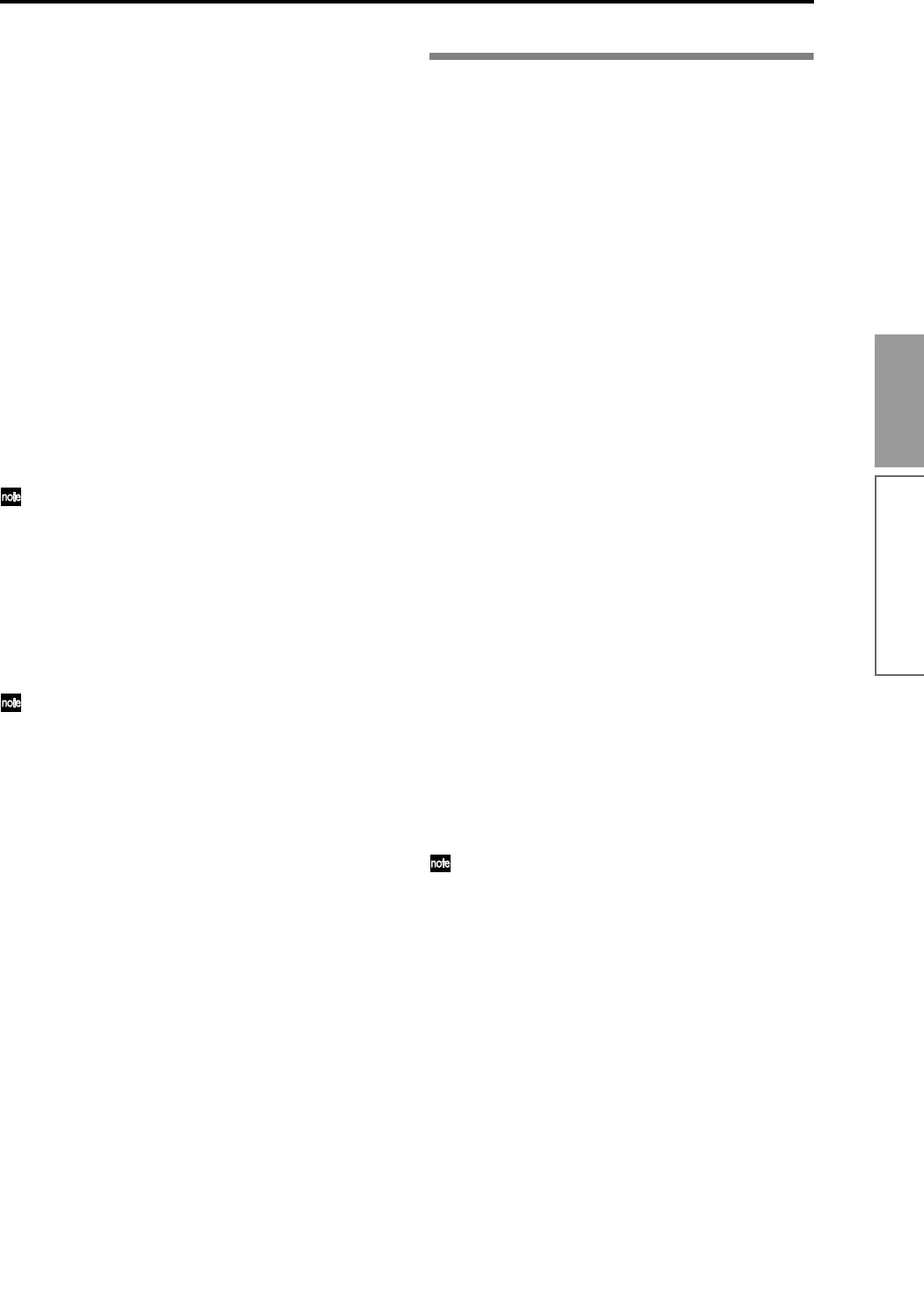
119
Basic functions
Sustain level (CC#70) [Bn, 46, vv]
Attack time (CC#73) [Bn, 49, vv]
Decay time (CC#75) [Bn, 4B, vv]
LFO 1 speed (CC#76) [Bn, 4C, vv]
LFO 1 depth (pitch) (CC#77) [Bn, 4D, vv]
LFO 1 delay (CC#78) [Bn, 4E, vv]
These messages are transmitted when assign the above
CC# to the REALTIME CONTROLS [1]–[4] knobs and
operate them.
When you operate these, the corresponding program
parameters will be controlled, and the sound and enve-
lope will change. When these messages are received,
the result will be the same as when the controller is
operated. (When the message has a value vv=64 [40],
the setting will have the value that was set by the pro-
gram parameter.)
• In Combination and Sequencer modes,
transmission/reception can be turned on/off
independently for each timbre/track (
☞p.35, 57 in
the Parameter Guide P3: MIDI Filter MIDI2 tab
“Enable REALTIME CONTROLS Knob 1, 2, 3, 4”).
In Program mode, the corresponding program
parameters will be temporarily edited by these
messages. You can Write the program to save the
modified state (except for certain parameters). The
Write operation can also be performed by a MIDI
exclusive Program Write Request message, in
addition to the usual method of using the TRI-
TON’s switches. When you write the data, the val-
ues of the corresponding program parameters will
be rewritten.
The results of receiving these messages will
depend on the instrument. The operation may be
different when a device other than the TRITON is
connected.
Silencing all notes on a specific channel
All note off (CC#123) [Bn, 7B, 00] (value 00)
When this is received, all currently-sounding notes on
that channel will be turned off (as though the keys had
been released). However, the release portion of the
notes will remain.
All sound off (CC#120) [Bn, 78, 00] (value 00)
When this is received, all currently-sounding notes on
that channel will be silenced. While the All Note Off
message allows the release portion of the notes to
remain, the All Sound Off message will silence the
notes immediately.
However, these messages are provided for emergency
use, and are not something that you will use while per-
forming.
Resetting all controllers on a specific channel
Reset all controllers (CC#121) [Bn, 79, 00] (value 00)
When this is received, the value of all controllers on
that channel will be reset.
Using RPN to edit
RPN (Registered Parameter Number) is a type of mes-
sage that allows settings to be made in a way that is
common between instrument manufacturers. (NRPN
(Non-registered Parameter Numbers) and exclusive
messages can be freely used in non-compatible ways
by different manufacturers and models of instrument.)
RPN messages can be used for editing with the follow-
ing procedure.
1 Use RPN MSB (CC#101) [Bn, 65, mm] and RPN LSB
(CC#100) [Bn, 64, rr] (n: channel, mm, rr: upper and
lower bytes of the parameter number) messages to
select the parameter.
2 Use data entry MSB (CC#6) [Bn, 06, mm] and data
entry LSB (CC#38) [Bn, 26, vv] (n: channel, mm, vv:
upper and lower bytes of the value, together
expressing 16,384 levels) to specify the value.
3 You can use data increment (CC#96) [Bn, 60,00] or
data decrement (CC#97) [Bn, 61, 00] (n: channel,
value is fixed at 00) to change the value in steps of
one.
The TRITON can receive the following three RPN mes-
sages (tuning, transpose, and pitch bend range).
Tuning
RPN fine tune [Bn, 65, 00, 64, 01]
This RPN message can be used to adjust the detuning
for a program or timbre (in Combination mode), or for
a track (in Sequencer or Song Play modes).
The procedure is as follows.
1 [Bn, 65, 00, 64, 01]: Select RPN parameter 01.
2 [Bn, 06, mm, 26, vv]: Use data entry to set the value.
A value of 8192 [mm, vv=40, 00] is center, 0 [mm,
vv=00, 00] is -100 cents, and 16383 [mm, vv=7F, 7F]
is +100 cents.
You can use the universal exclusive Fine Tune
message to adjust the overall tuning that corre-
sponds to the Global P0: Basic Setup “Master
Tune” parameter. (
☞p.120 “About system exclu-
sive messages”)
Transposing
RPN coarse tune [Bn, 65, 00, 64, 02]
This RPN message can be used to adjust the transposi-
tion for a program or timbre (in Combination mode),
or for a track (in Sequencer or Song Play modes).
The procedure is as follows.
1 [Bn, 65, 00, 64, 02]: Select RPN parameter 02.
2 [Bn, 06, mm, 26, vv]: Use data entry to set the value.
Normally only the upper byte is used.
A value of 8192 [mm, vv=40, 00] is center, 6656 [mm,
vv=34, 00] is -12 semitones, and 9728 [mm, vv=4C, 00]
is +12 semitones.
MIDI applications


















